Not all of your website visitors are there for the same reason. Some might be return visitors ready to buy your product, while others might be first-time visitors still researching their best options.
The reality is, too many websites and post-click landing pages display the same content for all visitors, no matter their intentions, or how they arrived on your page. Since these sites attempt to appeal to the masses, it’s likely that they’re not exciting or intriguing many prospects.
There is a better way to speak directly to each visitor. To display different content and calls-to-action for each visitor, so they all feel like the page was designed specifically for them. Enter content personalization.
What is content personalization?
Content personalization is the act of tailoring different types of content to individual consumers, based on their personal data available to you. Attainable information (e.g. location, search queries, ads they clicked on, website visit and purchase history, etc.) is compared against a set of variables you’ve put into place, including (not limited to):
- Gender
- Age
- Location (city, country, region)
- Device (smartphone, tablet, iOS, Android, Windows, Mac, Linux, etc.)
- Visitor frequency
- Date and time of day, proximity to payday
- Referring URL
- Purchase history (whether they’ve purchased before, what it was, how much it cost)
- Sessions behavior (navigation clicks, page views, etc.)
The process looks like this:
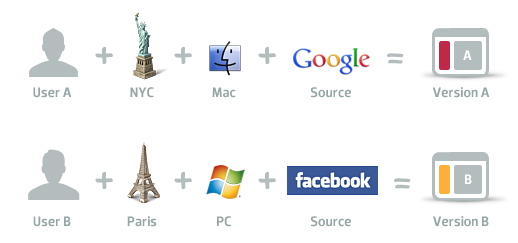
The growth of personalization
Personalization has become so widely adopted as a marketing strategy, with 92% of marketers reporting usage in some way:

When that same 92% of marketers were asked where, specifically, they utilize personalized experiences, they revealed this:
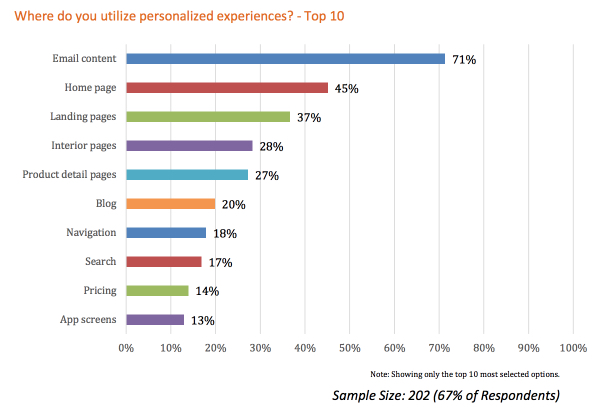
It’s important to think about the user experience as a whole, though, since there will likely be multiple interactions with your brand prior to any purchase. From the content you deliver to the web experience you provide, your goal is to incorporate personalization throughout the entire journey to make it more engaging. To start, you should understand the difference between content and web personalization.
Why content personalization is not the same as web personalization
Dynamic content personalization automatically changes content shown to users based on customer segmentation variables and other database-driven signals. It can be used with promotions (email, social, etc.) to drive the right eyes to the right content experiences and product listings.
However, if everyone who clicks on your dynamic promotion creative arrives at the same generic, static web page, you’ll likely disappoint many people lose a lot of prospects. That’s why you also need web personalization.
Web personalization changes a website’s presentation in real-time, based on the user’s preferences and past interactions. So after they’ve clicked your personalized content, they also receive a web experience that continues to meet their needs and guide them through a personalized conversion funnel.
A perfect example is Amazon. Every Amazon customer has a personalized homepage based on their browsing history and previous shopping experiences. Also, international visitors automatically get product information presented to them in their native language and currency.
Here’s another great example — on the first page, there is a female visitor who lives in the US during the summer. So she’s shown watches for women that are perfect for summertime, with an offer for free shipping within the US:
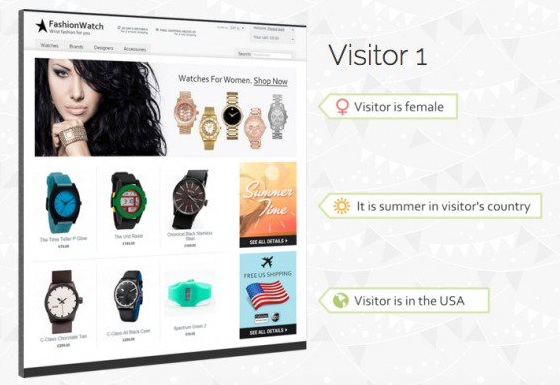
On another page, there is a first-time male visitor who lives outside the US and has previously shown interest in the Nixon brand. He’s shown men’s Nixon watches with an offer for 10% off his first order, and a notification that they ship worldwide:
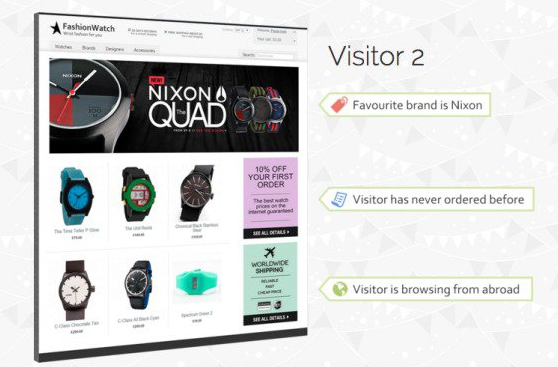
Now imagine if either visitor arrived at the other page. They’d likely be confused, turned off, and leave the page quickly. Because while one version of a page can make someone feel like an individual, another can make them lose interest immediately.
The point is this: Content personalization and web personalization are not two separate marketing tactics. They can work perfectly together — and should be used together — to develop the highly personalized customer experiences that today’s consumers crave.
4 Content personalization examples
1. Segmentation
This is the most popular type used by 68% of marketers:
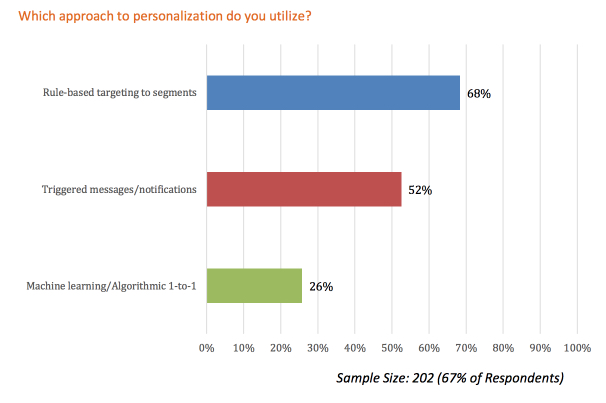
Marketers can target audiences by variables such as industry, department, job title, geography, gender, age range, and more. To demonstrate, there’s a good chance this Instagram ad targets female users:
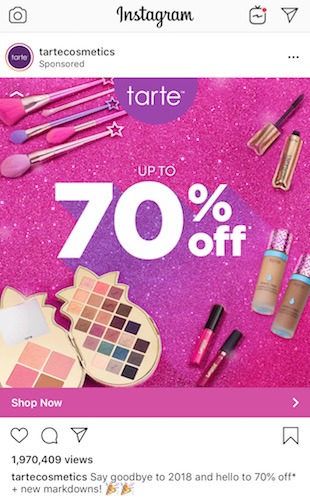
An audience can even be segmented by behavior. With insight into interests, preferences, and past interactions with your brand, you can anticipate what a customer needs, and deliver perfectly matched, relevant, personalized content that drives conversions.
While segmentation is great for increasing the overall relevancy of emails and website experiences (and improving general engagement), the level of personalization is limited to ensure your content appeals to an entire segment of people.
2. Persona-based personalization
Many brands take segmentation a step further and rely on personas to generate relevant content. As the name implies, a persona-based personalization strategy involves segmenting content by the characteristics of each persona, which can be anecdotal or more data-driven, based on website activity, purchase history, demographics, etc.
This Google Ads promotion likely appeared on my Facebook newsfeed because I’m an entrepreneur running paid ads on Facebook and Instagram. Therefore, the platform knows I might consider advertising on Google as well to find new customers for my growing business:
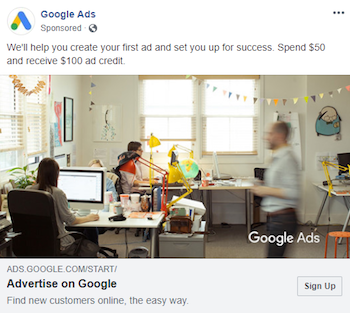
As you increasingly collect more data over time, you can refine each persona to enhance your personalization efforts further. This is especially useful for account-based marketing personalization when you’re trying to engage specific accounts.
3. Customer journey-based personalization
To evolve broad-based content into content that’s relevant to each step in the customer journey, customer journey maps are necessary. Your map should address which audiences to focus on, and at which stage of the journey, so you can align your content to each stage. This lets you deliver personalized content directly related to a customer’s phase in their journey, helping them progress to the next step.
A post-click landing page used in the awareness stage of the buyer’s journey, for instance, should only focus on warming your customer up with a free resource or soft-sell, rather than overtly promoting a product or solution.
For example, Instapage’s Marketing Stock Photos guide is meant for marketers wanting to select better, more relevant stock photos in all their campaigns. So instead of promoting Instapage as a post-click landing page solution, it offers marketers a resource on using stock imagery in their marketing content:
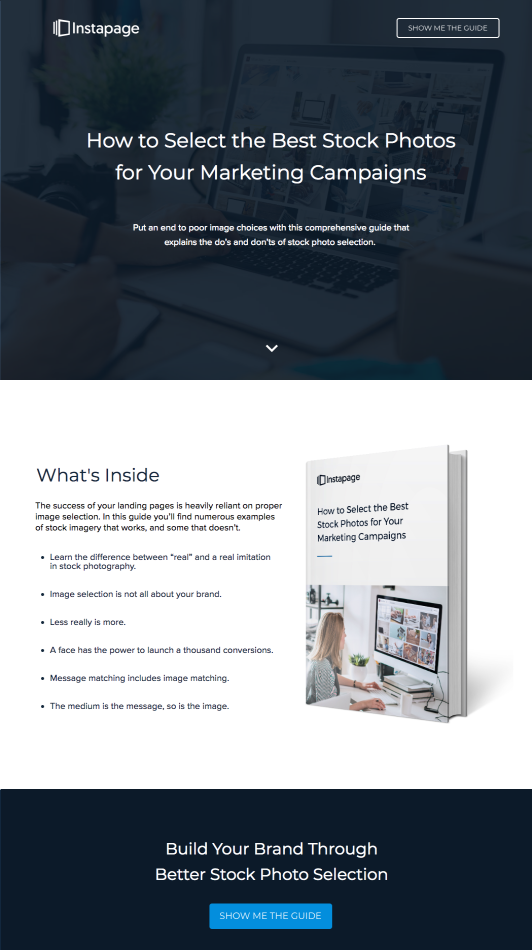
In doing so, it simply offers information necessary to make an informed decision at the next stage of the journey.
4. Individual-specific personalization
Although the three methods above are all great approaches to personalization, they’re based on delivering content to broad audiences. Yet, with the evolution of advertising, consumers no longer accept one-size-fits-all (or even one-size-fits-some) content experiences. And with all of the changes to advertising over the years, there’s no reason they should have to.
The only way to truly personalize the customer experience is to a segment of one, optimized in real-time. This is known as individual-specific personalization and should be based on the actions and preferences inextricably tied to that specific customer’s identity. This individualization is possible primarily through machine learning and AI technology, used by over a quarter of marketers today.
By aggregating and analyzing customer data in real time, AI-driven content personalization uses both first and third party data to make intelligent decisions with each customer interaction across channels. This extreme level of personalization can deliver relevant content in the form of post-click landing pages, special offers, product recommendations, or one-to-one emails:
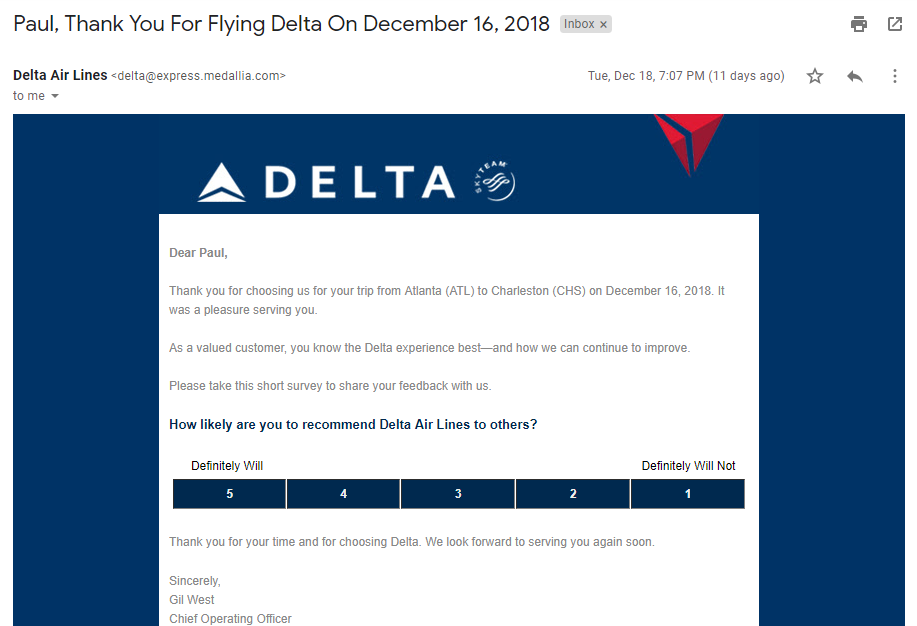
There’s no question that this email was meant for its recipient, as it contains his name, the date he flew, and the destinations.
So what’s the point of all this?
Marketers can use content personalization software and strategies to improve the customer experience, and in turn, increase conversions.
In fact, the top five benefits of personalization have positive effects on both the brand-customer relationship (increased visitor engagement, improved customer experience, and improved brand perception) and the organization’s bottom line (increased conversion rates and increased lead generation/customer acquisition):
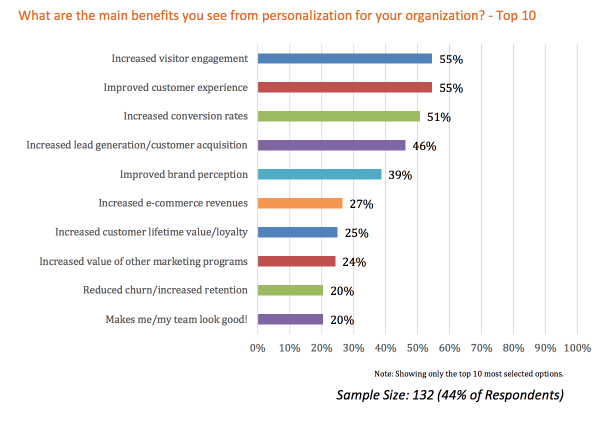
Take the extra step and add a personal touch
Businesses that do so are often the ones that have the most loyal customers. That’s because content personalization can transform a simple customer interaction into a unique and engaging experience. So whether you’re personalizing your emails, social media posts, website, or post-click landing pages, the connection your business builds will increase brand awareness, drive conversions, and win loyal customers.
Once you’ve ensured your content is highly personalized for its audience, get even more out of your post-click opportunities with the digital personalization guide below.
